Презентация lect.3 EQUIVALENCE IN TRANSLATION

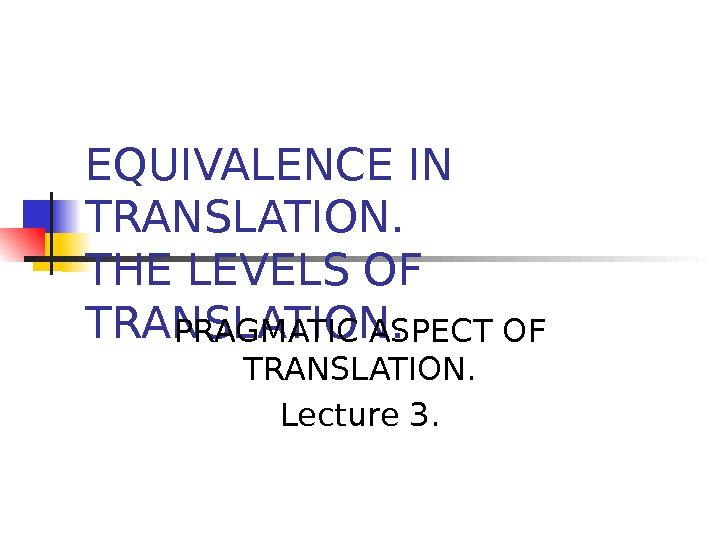
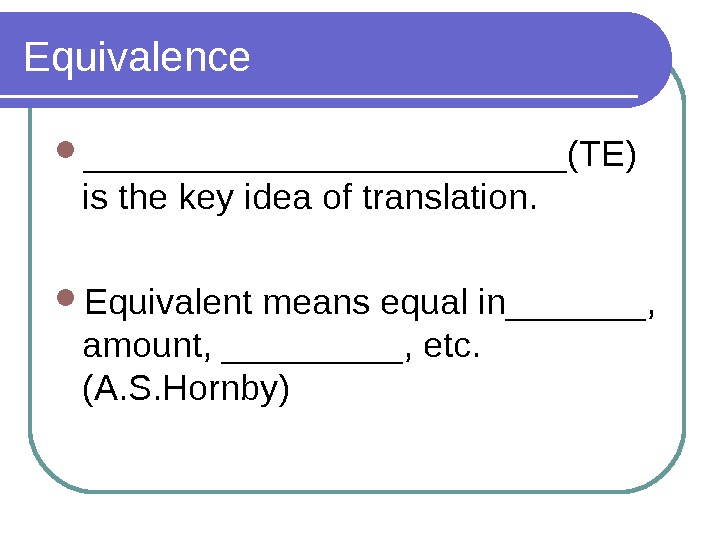




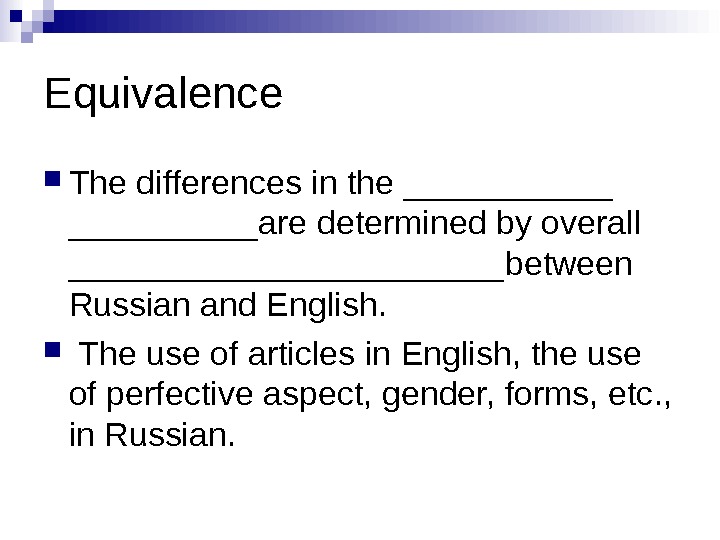

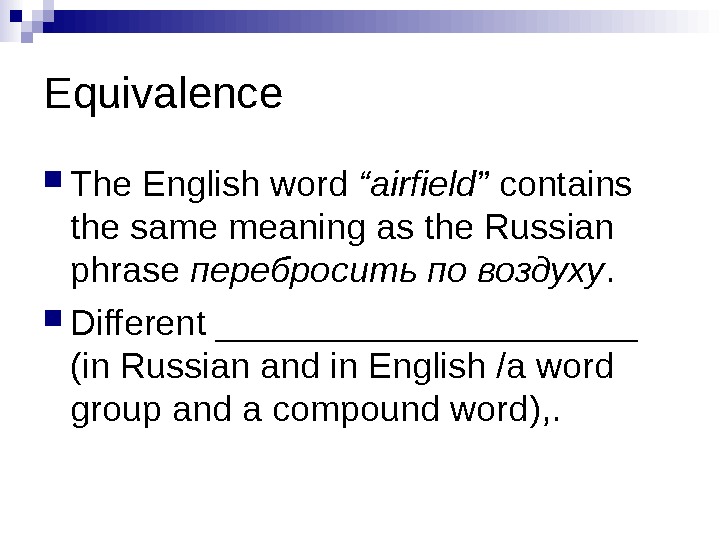
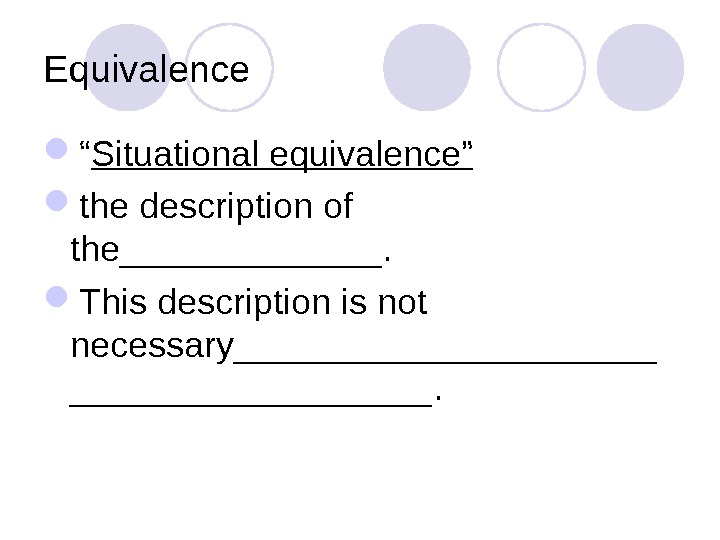

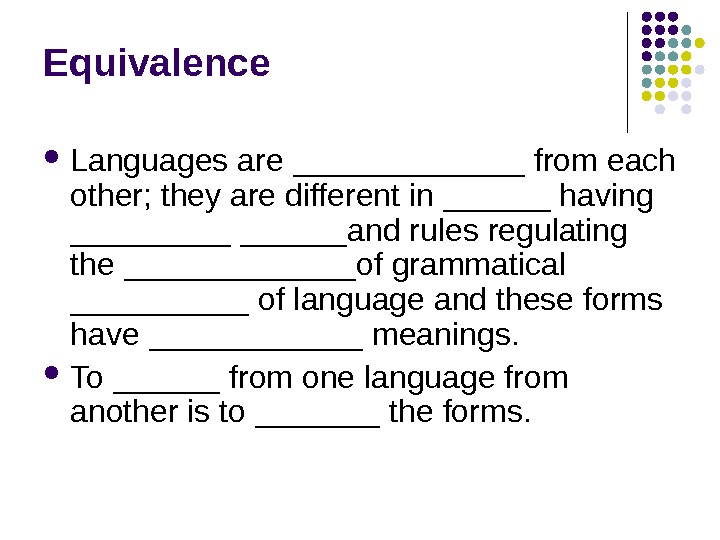
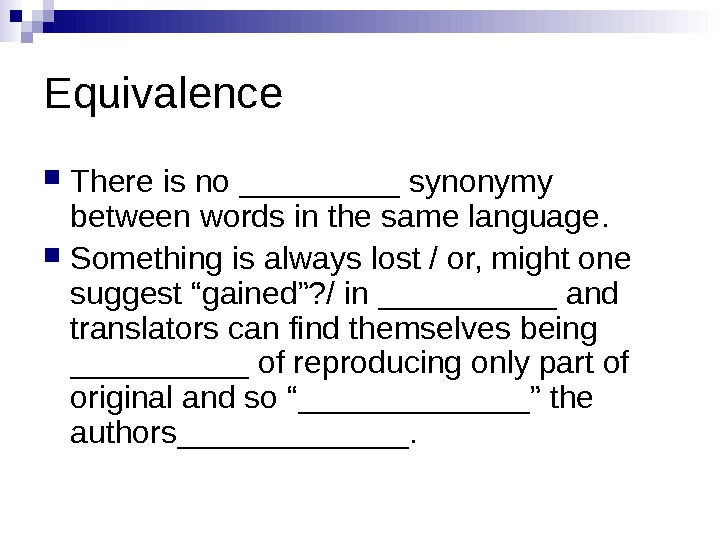


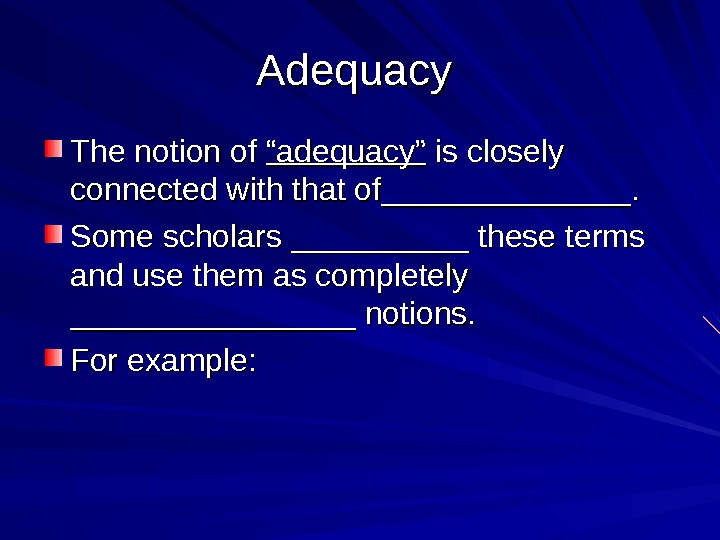



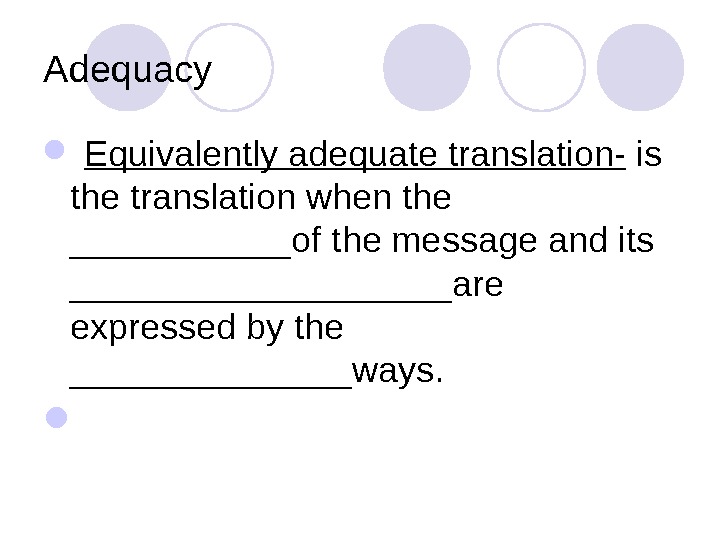





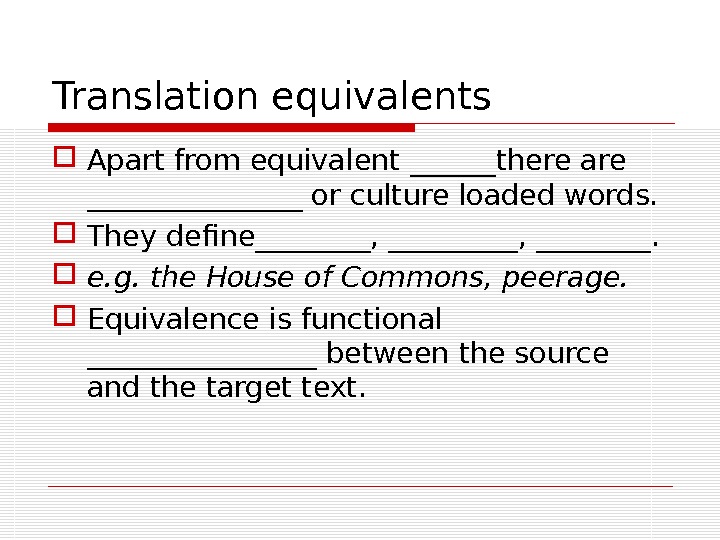

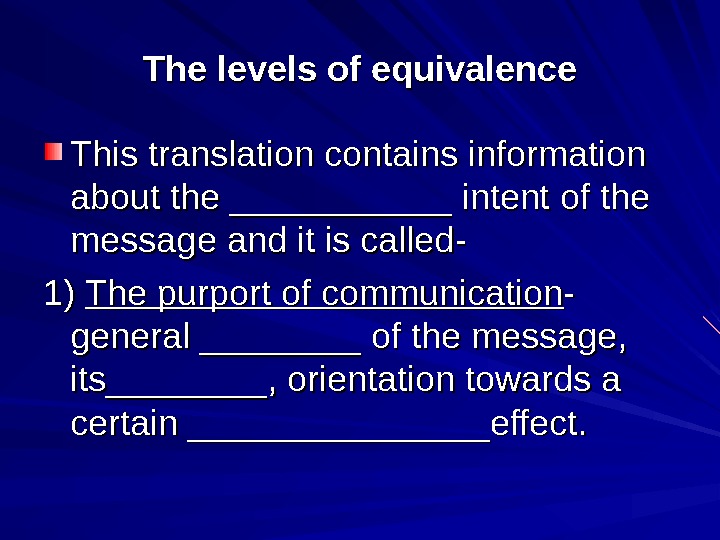
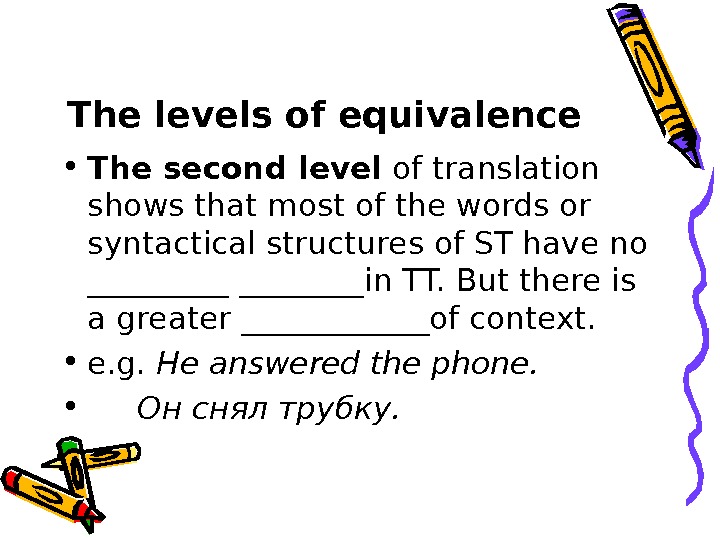

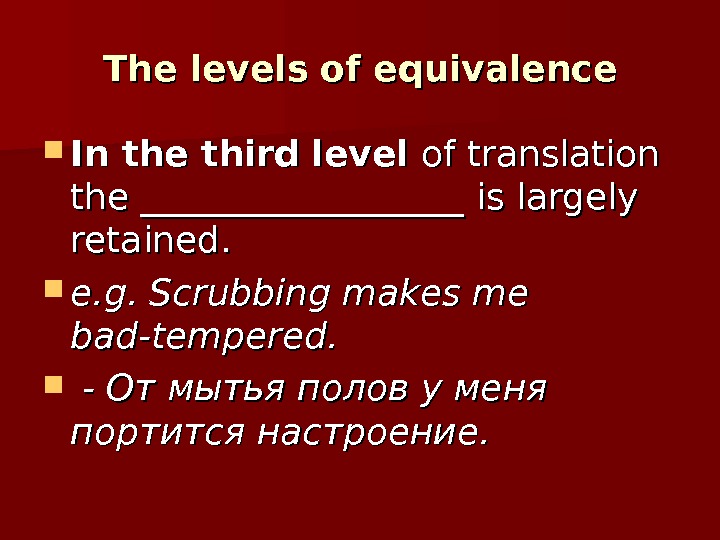



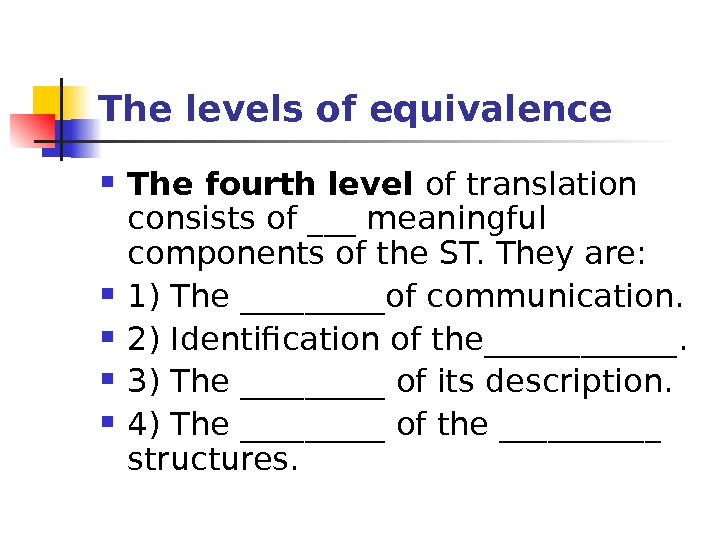

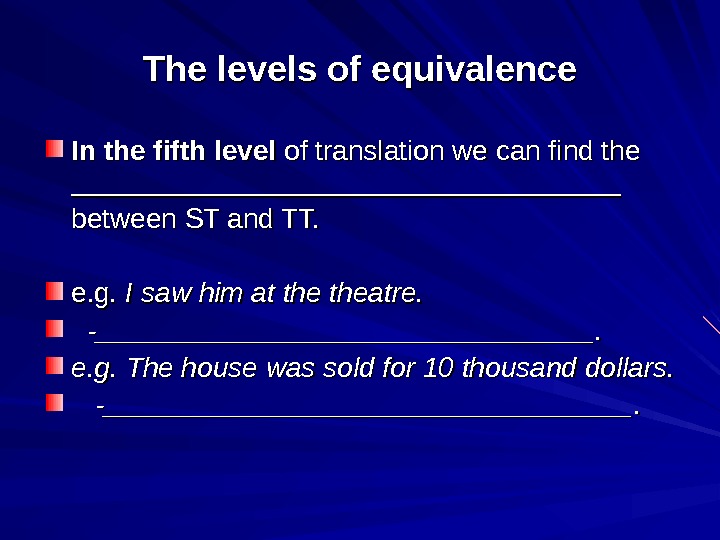





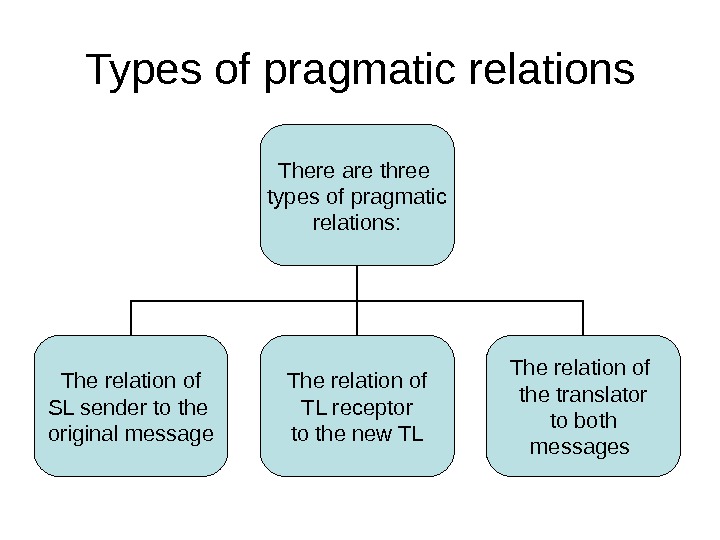
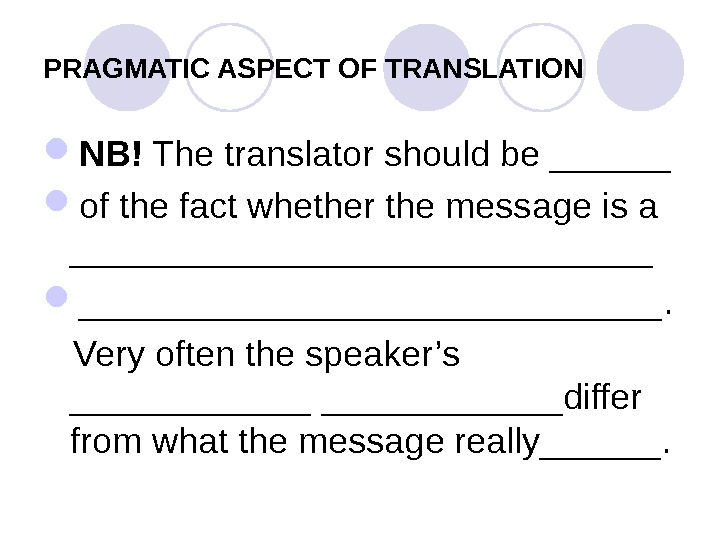
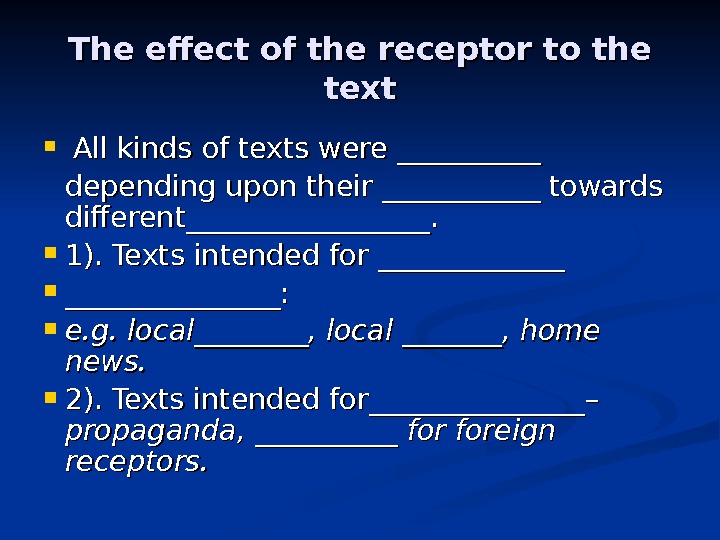

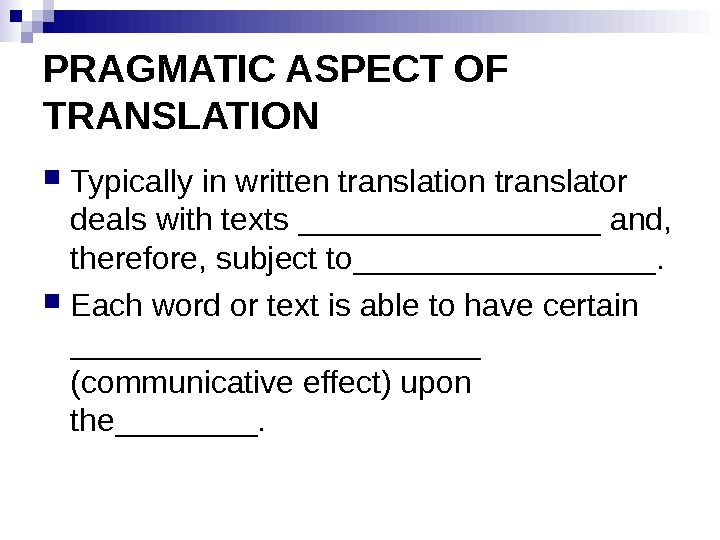



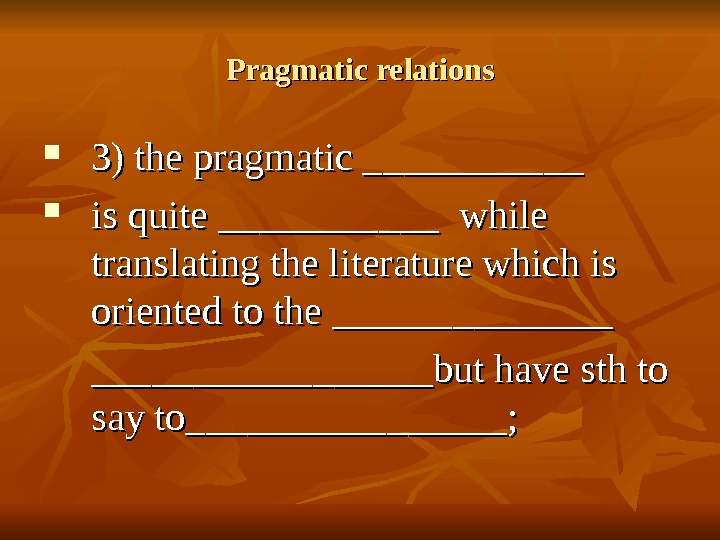


- Размер: 2.8 Mегабайта
- Количество слайдов: 53
Описание презентации Презентация lect.3 EQUIVALENCE IN TRANSLATION по слайдам
 EQUIVALENCE IN TRANSLATION. THE LEVELS OF TRANSLATION. PRAGMATIC ASPECT OF TRANSLATION. Lecture 3.
EQUIVALENCE IN TRANSLATION. THE LEVELS OF TRANSLATION. PRAGMATIC ASPECT OF TRANSLATION. Lecture 3.
 Equivalence ____________(TE) is the key idea of translation. Equivalent means equal in_______, amount, _____, etc. (A. S. Hornby)
Equivalence ____________(TE) is the key idea of translation. Equivalent means equal in_______, amount, _____, etc. (A. S. Hornby)
 Equivalence is the central issue in translation. I ts _____ , ______ , and ________ within the field of translation theory have caused __________________. M any different theories of the concept of equivalence have been _____ within this field for the past _______ years.
Equivalence is the central issue in translation. I ts _____ , ______ , and ________ within the field of translation theory have caused __________________. M any different theories of the concept of equivalence have been _____ within this field for the past _______ years.
 Equivalence The most innovative theorists (____ and Darbelnet, _____ , Nida and _____ , Catford, _______ , and finally Baker ) have studied equivalence in relation to the _______________ , using different approaches.
Equivalence The most innovative theorists (____ and Darbelnet, _____ , Nida and _____ , Catford, _______ , and finally Baker ) have studied equivalence in relation to the _______________ , using different approaches.
 Equivalence V. G. Gark and I. N. Levin distinguish the following types of equivalents: formal , _____ and _____. Formal equivalence Semantic equivalence.
Equivalence V. G. Gark and I. N. Levin distinguish the following types of equivalents: formal , _____ and _____. Formal equivalence Semantic equivalence.
 Equivalence • Formal equivalence may be illustrated by speech cases as: • The sun disappeared behind a cloud – солнце скрылось за тучей. • Here we find _________ in addition to the similarity.
Equivalence • Formal equivalence may be illustrated by speech cases as: • The sun disappeared behind a cloud – солнце скрылось за тучей. • Here we find _________ in addition to the similarity.
 Equivalence The differences in the ______ are determined by overall ____________ between Russian and English. The use of articles in English, the use of perfective aspect, gender, forms, etc. , in Russian.
Equivalence The differences in the ______ are determined by overall ____________ between Russian and English. The use of articles in English, the use of perfective aspect, gender, forms, etc. , in Russian.
 Equivalence Semantic equivalence exists when the _________ are expressed in the two languages in a way. Example: — Troops were airlifted to the battlefield — B ойска были переброшены по воздуху на поле.
Equivalence Semantic equivalence exists when the _________ are expressed in the two languages in a way. Example: — Troops were airlifted to the battlefield — B ойска были переброшены по воздуху на поле.
 Equivalence The English word “airfield” contains the same meaning as the Russian phrase перебросить по воздуху. D ifferent ___________ ( in Russian and in English /a word group and a compound word ), .
Equivalence The English word “airfield” contains the same meaning as the Russian phrase перебросить по воздуху. D ifferent ___________ ( in Russian and in English /a word group and a compound word ), .
 Equivalence “ S ituational equivalence” the description of the _______. This description is not necessary ___________.
Equivalence “ S ituational equivalence” the description of the _______. This description is not necessary ___________.
 Equivalence Texts in different languages can be equivalent in different degrees/ _______ or ___________ / in respect of different levels of ______ /equivalent in respect of ____ , of _____ , of grammar, of _____ , etc. / and at different ranks / _______________________________ /.
Equivalence Texts in different languages can be equivalent in different degrees/ _______ or ___________ / in respect of different levels of ______ /equivalent in respect of ____ , of _____ , of grammar, of _____ , etc. / and at different ranks / _______________________________ /.
 Equivalence Languages are _______ from each other; they are different in ______ having ______ and rules regulating the _______ of grammatical _____ of language and these forms have ______ meanings. To ______ from one language from another is to _______ the forms.
Equivalence Languages are _______ from each other; they are different in ______ having ______ and rules regulating the _______ of grammatical _____ of language and these forms have ______ meanings. To ______ from one language from another is to _______ the forms.
 Equivalence T here is no _____ synonymy between words in the same language. Something is always lost / or, might one suggest “gained”? / in _____ and translators can find themselves being _____ of reproducing only part of original and so “ _______ ” the authors _______.
Equivalence T here is no _____ synonymy between words in the same language. Something is always lost / or, might one suggest “gained”? / in _____ and translators can find themselves being _____ of reproducing only part of original and so “ _______ ” the authors _______.
 Equivalence If equivalence is to be “ _____ ” at a particular level at _____ , which level is to be? What are the alternatives? The answer ______ the _______ nature of language itself.
Equivalence If equivalence is to be “ _____ ” at a particular level at _____ , which level is to be? What are the alternatives? The answer ______ the _______ nature of language itself.
 Equivalence Language is a ________ – a code –which consists of elements which can ______ to signal semantic “sense” and, at the same time, a _______ system which uses the forms of the _______ to refer to _____ /in the word/and create ______ which possess communicative “value”.
Equivalence Language is a ________ – a code –which consists of elements which can ______ to signal semantic “sense” and, at the same time, a _______ system which uses the forms of the _______ to refer to _____ /in the word/and create ______ which possess communicative “value”.
 Adequacy The notion of “adequacy” is closely connected with that of______________. Some scholars __________ these terms and use them as completely ________________ notions. For example:
Adequacy The notion of “adequacy” is closely connected with that of______________. Some scholars __________ these terms and use them as completely ________________ notions. For example:
 Adequacy J. Catford’s notion of “translation______” is treated as “________ of translation”. R. Levitsky in his article “On the principle of ______ adequacy of translation”. V. N. Komissarov, for instance, thinks that ______ translation” has a _______ meaning and is used as a synonym for “a _______ translation” that guarantees sufficient _______ communication.
Adequacy J. Catford’s notion of “translation______” is treated as “________ of translation”. R. Levitsky in his article “On the principle of ______ adequacy of translation”. V. N. Komissarov, for instance, thinks that ______ translation” has a _______ meaning and is used as a synonym for “a _______ translation” that guarantees sufficient _______ communication.
 Adequacy • ““ Equivalence” is regarded as ……………. . • ……………. . of the S. and T. language and ……………. units. • Adequate translation — is the translation performed _________________ and necessary to ____________ the information and __________ the __________ of the TL.
Adequacy • ““ Equivalence” is regarded as ……………. . • ……………. . of the S. and T. language and ……………. units. • Adequate translation — is the translation performed _________________ and necessary to ____________ the information and __________ the __________ of the TL.
 Adequacy Everything said in one language can be said in another. We mean by contents not only …………. -……………… contents but all the information inherited in the original message including its ………………. and ……………………… charge and ………………………. peculiarities. .
Adequacy Everything said in one language can be said in another. We mean by contents not only …………. -……………… contents but all the information inherited in the original message including its ………………. and ……………………… charge and ………………………. peculiarities. .
 Adequacy Equivalently adequate translation- is the translation when the ______of the message and its __________are expressed by the _______ways.
Adequacy Equivalently adequate translation- is the translation when the ______of the message and its __________are expressed by the _______ways.
 Adequacy E. g. bird cherry tree – черемуха. In English it’s only a botanical term. In Russian it has different emotional applications – “ весна ”, “ любовь ”. Apart from denoting a botanical tree the word “bird cherry tree” acquired ______________meaning.
Adequacy E. g. bird cherry tree – черемуха. In English it’s only a botanical term. In Russian it has different emotional applications – “ весна ”, “ любовь ”. Apart from denoting a botanical tree the word “bird cherry tree” acquired ______________meaning.
 Adequacy NB! Taking into consideration that equivalent is a _________________ that exists independently upon the____________. We have the possibility to state that adequate translation may be ___________ and____________.
Adequacy NB! Taking into consideration that equivalent is a _________________ that exists independently upon the____________. We have the possibility to state that adequate translation may be ___________ and____________.
 Adequacy e. g. The fresh air revived most of the men and the thought of beer at the nearest pub stimulated sluggish pulses. The thought of beer – мысль о пиве – equivalent translation; — M ысль о кружке пива – adequate translation.
Adequacy e. g. The fresh air revived most of the men and the thought of beer at the nearest pub stimulated sluggish pulses. The thought of beer – мысль о пиве – equivalent translation; — M ысль о кружке пива – adequate translation.
 Translation equivalents Y. Retsker differentiates: — — Absolute equivalents – this is a case when a SL word is_____________, _________________ and _________________synonymous to a TL word. E. g. geographical and proper names, technical terms, etc.
Translation equivalents Y. Retsker differentiates: — — Absolute equivalents – this is a case when a SL word is_____________, _________________ and _________________synonymous to a TL word. E. g. geographical and proper names, technical terms, etc.
 Translation equivalents — — Partial equivalents the range of meaning does not __________in two languages. e. g. differentiation – рука : hand, arm.
Translation equivalents — — Partial equivalents the range of meaning does not __________in two languages. e. g. differentiation – рука : hand, arm.
 Translation equivalents Apart from equivalent ______there are ________ or culture loaded words. They define________, ________. e. g. the House of Commons, peerage. Equivalence is functional ________ between the source and the target text.
Translation equivalents Apart from equivalent ______there are ________ or culture loaded words. They define________, ________. e. g. the House of Commons, peerage. Equivalence is functional ________ between the source and the target text.
 The levels of equivalence according to V. Komissarov The first level includes the translation in which the _____of ____________with ST is the________. e. g. Maybe there is some chemistry between us that does not mix. Бывает, что люди не сходятся характерами.
The levels of equivalence according to V. Komissarov The first level includes the translation in which the _____of ____________with ST is the________. e. g. Maybe there is some chemistry between us that does not mix. Бывает, что люди не сходятся характерами.
 The levels of equivalence This translation contains information about the ___________ intent of the message and it is called- 1) 1) The purport of communication — — general ________ of the message, its________, orientation towards a certain _______________effect.
The levels of equivalence This translation contains information about the ___________ intent of the message and it is called- 1) 1) The purport of communication — — general ________ of the message, its________, orientation towards a certain _______________effect.
 The levels of equivalence • The second level of translation shows that most of the words or syntactical structures of ST have no _____in TT. But there is a greater ______of context. • e. g. He answered the phone. • Он снял трубку.
The levels of equivalence • The second level of translation shows that most of the words or syntactical structures of ST have no _____in TT. But there is a greater ______of context. • e. g. He answered the phone. • Он снял трубку.
 The levels of equivalence So here we can find: 1). The purport of_______. 2). _______of the situation.
The levels of equivalence So here we can find: 1). The purport of_______. 2). _______of the situation.
 The levels of equivalence In the third level of translation the __________________ is largely retained. e. g. Scrubbing makes me bad-tempered. — От мытья полов у меня портится настроение.
The levels of equivalence In the third level of translation the __________________ is largely retained. e. g. Scrubbing makes me bad-tempered. — От мытья полов у меня портится настроение.
 The levels of equivalence So in TT there are: 1). The _____of communication. 2). Identification of the______. 3). The method of its_______.
The levels of equivalence So in TT there are: 1). The _____of communication. 2). Identification of the______. 3). The method of its_______.
 The levels of equivalence e. g. London saw a cold winter last year. e. g. You are not serious? — — В прошлом году зима в Лондоне была холодной. — — Вы. Вы шутите ? ? Two ___________complexes as well as the ___________of describing the situation.
The levels of equivalence e. g. London saw a cold winter last year. e. g. You are not serious? — — В прошлом году зима в Лондоне была холодной. — — Вы. Вы шутите ? ? Two ___________complexes as well as the ___________of describing the situation.
 The levels of equivalence This means that the translation is a ______ of the original, preserving its basic ______ and allowing their ___________ in the sentence.
The levels of equivalence This means that the translation is a ______ of the original, preserving its basic ______ and allowing their ___________ in the sentence.
 The levels of equivalence The fourth level of translation consists of ___ meaningful components of the ST. They are: 1) The _____of communication. 2) Identification of the______. 3) The _____ of its description. 4) The _____ of the _____ structures.
The levels of equivalence The fourth level of translation consists of ___ meaningful components of the ST. They are: 1) The _____of communication. 2) Identification of the______. 3) The _____ of its description. 4) The _____ of the _____ structures.
 The levels of equivalence E. g. I don’t see that I need to convince you. — ______________ E. g. He was standing with his arms crossed and his bare head bent. -_______________
The levels of equivalence E. g. I don’t see that I need to convince you. — ______________ E. g. He was standing with his arms crossed and his bare head bent. -_______________
 The levels of equivalence In the fifth level of translation we can find the ___________________________________ between ST and TT. e. g. I saw him at the theatre. — ________________________________. . e. g. The house was sold for 10 thousand dollars. — __________________________________. .
The levels of equivalence In the fifth level of translation we can find the ___________________________________ between ST and TT. e. g. I saw him at the theatre. — ________________________________. . e. g. The house was sold for 10 thousand dollars. — __________________________________. .
 The levels of equivalence There are 5 levels of equivalence in this TT: 1) The purport of communication. 2) Identification of the situation. 3) The method of description of the situation. 4) The invariant meaning of the syntactical structures. 5) The level of word semantics.
The levels of equivalence There are 5 levels of equivalence in this TT: 1) The purport of communication. 2) Identification of the situation. 3) The method of description of the situation. 4) The invariant meaning of the syntactical structures. 5) The level of word semantics.
 The levels of equivalence E. g. the Organization is based on the principle of the sovereign equality of all its Members. — __________________________________________________________.
The levels of equivalence E. g. the Organization is based on the principle of the sovereign equality of all its Members. — __________________________________________________________.
 The levels of equivalence The relative identity of the contents of the two texts depends in this case on the __________ to which various components of the __________________ can be rendered in translation without ______________________________ information contained in the original.
The levels of equivalence The relative identity of the contents of the two texts depends in this case on the __________ to which various components of the __________________ can be rendered in translation without ______________________________ information contained in the original.
 PRAGMATIC ASPECT OF TRANSLATION Pragmatics is the____________________________. Pragmatic relations are __________ on ________ relations and play an equally important role in ________ the original text and in __________ an ___________text in the TL.
PRAGMATIC ASPECT OF TRANSLATION Pragmatics is the____________________________. Pragmatic relations are __________ on ________ relations and play an equally important role in ________ the original text and in __________ an ___________text in the TL.
 PRAGMATIC ASPECT OF TRANSLATION ____________ do not necessarily mean the ______ to the source and target ______ and, therefore, are not necessarily ____________.
PRAGMATIC ASPECT OF TRANSLATION ____________ do not necessarily mean the ______ to the source and target ______ and, therefore, are not necessarily ____________.
 Types of pragmatic relations There are three types of pragmatic relations: The relation of SL sender to the original message The relation of TL receptor to the new TL The relation of the translator to both messages
Types of pragmatic relations There are three types of pragmatic relations: The relation of SL sender to the original message The relation of TL receptor to the new TL The relation of the translator to both messages
 PRAGMATIC ASPECT OF TRANSLATION NB! The translator should be ______ of the fact whether the message is a _____________________________. Very often the speaker’s ____________differ from what the message really______.
PRAGMATIC ASPECT OF TRANSLATION NB! The translator should be ______ of the fact whether the message is a _____________________________. Very often the speaker’s ____________differ from what the message really______.
 The effect of the receptor to the text All kinds of texts were __________ depending upon their ___________ towards different_________________. 1). Texts intended for _______________: e. g. local________, local _______, home news. 2). Texts intended for_______________ – – propaganda, __________ for foreign receptors.
The effect of the receptor to the text All kinds of texts were __________ depending upon their ___________ towards different_________________. 1). Texts intended for _______________: e. g. local________, local _______, home news. 2). Texts intended for_______________ – – propaganda, __________ for foreign receptors.
 PRAGMATIC ASPECT OF TRANSLATION 3). Texts intended ______for __ _____, but having also a ______ human appeal. 4). Texts ___________ (technical literature, instruction).
PRAGMATIC ASPECT OF TRANSLATION 3). Texts intended ______for __ _____, but having also a ______ human appeal. 4). Texts ___________ (technical literature, instruction).
 PRAGMATIC ASPECT OF TRANSLATION Typically in written translation translator deals with texts _________ and, therefore, subject to_________. Each word or text is able to have certain ____________ (communicative effect) upon the____.
PRAGMATIC ASPECT OF TRANSLATION Typically in written translation translator deals with texts _________ and, therefore, subject to_________. Each word or text is able to have certain ____________ (communicative effect) upon the____.
 The character of such an influence depends upon three factors: 3 factors Contents of the word expression The character of the signs that the word expression involves The receptor Message can have different effect on receptors e. g. a disco grand mother – a teenager
The character of such an influence depends upon three factors: 3 factors Contents of the word expression The character of the signs that the word expression involves The receptor Message can have different effect on receptors e. g. a disco grand mother – a teenager
 Four types of pragmatic relations according to Nyberg 1) the pragmatics of the ST is _____in the______, when this text is of the ___________ both for the reader of the ____and of the _______ (scientific literature);
Four types of pragmatic relations according to Nyberg 1) the pragmatics of the ST is _____in the______, when this text is of the ___________ both for the reader of the ____and of the _______ (scientific literature);
 Pragmatic relations 2) the pragmatics of the ST is _________ in the translation ________________ when the ST is created _______________ (different materials for foreign readers);
Pragmatic relations 2) the pragmatics of the ST is _________ in the translation ________________ when the ST is created _______________ (different materials for foreign readers);
 Pragmatic relations 3) the pragmatic ___________ is quite ___________ while translating the literature which is oriented to the _________________but have sth to say to________________;
Pragmatic relations 3) the pragmatic ___________ is quite ___________ while translating the literature which is oriented to the _________________but have sth to say to________________;
 Pragmatic relations 4) the ST is _____ only for the __________ and does not have ______ towards the ______ of the _______ (governmental acts, political and economic press).
Pragmatic relations 4) the ST is _____ only for the __________ and does not have ______ towards the ______ of the _______ (governmental acts, political and economic press).
 Questions Text-book: Lectures 6, 7 – pp. 49 -54, 58 -64. Questions – pp. 55, 65. Ex-s: pp. 65 -67. Presentation : ”Different Approaches Of Translation Theorists To The Problem Of Equivalence”.
Questions Text-book: Lectures 6, 7 – pp. 49 -54, 58 -64. Questions – pp. 55, 65. Ex-s: pp. 65 -67. Presentation : ”Different Approaches Of Translation Theorists To The Problem Of Equivalence”.

